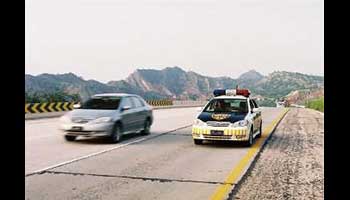|
- Not drive a motor vehicle, unless it is in fit Mechanical and Technical condition, and fulfills the required criteria of a technically fit car as per rule.
- Observe the speed limits as indicated by an appropriate sign.
- Give appropriate light or manual signals before starting, stopping, slowing down turning or changing lanes, clearly, correctly and well in time as laid down in the sixth schedule.
- Not drive a vehicle without wearing a seatbelt and properly functioning lights and indicators.
- Ensure that the view through the rear-view mirror is not obstructed in any way.
- Keep the rear screen of the vehicle, if installed, clear all the times.
- While following the other vehicle maintain the appropriate distance as per speed.
- Drive with full attention and care.
- Not attempt to gain a forward position by jumping the queue.
- Give way to ambulance, fire engine, police vehicles and funerals.
- Not cross a single or double unbroken continues line marked on the road in any circumstances except when getting on or out of the premises.
- Not use indicators un-necessarily.
- Always overtake by following the rules and regulations.
- Not occupy the extreme right lane for overtaking purpose on a three-lane road with two-way traffic.
- Break of Journey for 20 Minutes after 3 hours continuous drive.
- Use coolant instead of water in radiator.
- Keep an eye on the temperature gauge.
- Over heating can lead to engine seizure.
- In Case of Engine Over Heating:
- Don't switch off the engine.
- Pour water on the radiator.
- Don't open the radiator cap
- Do not exceed speed limits.
- Reduce speed near schools and hospitals.
- Reduce speed in residential/shopping areas.
- Reduce speed at night and in bad weather.
- Maximum Speed Limits are for mechanically fit vehicles. If your vehicle is old please drive within suitable limit.
- Seatbelts protects in the event of sudden application of brakes or in case of an accident.
- Use approved Safety Helmet.
- Wear it securely.
- The driver and the pillion rider must wear it for their safety.
- Damage to vehicle.
- Cause accidents.
- Cause damage to road.
- Check the POWER before going on Road:
- P-Petrol.
- O-Oil.
- W-Water
- E-Electric
- R-Rubber (Tires & Belts)
- Over Hanging Loads:
- Keep load within the dimensions of the vehicle.
- Mark ends of the load with red flags by day.
- Mark ends of the load with red lights and reflectors by night.
-
There is a manifold increase in the number of accidents during the foggy season.
-
Before traveling do think that your journey is absolutely necessary, if "NO" than postpone it and if "YES" than delay it as much as possible.
-
Ensure that windscreen, windows, side view mirrors, headlights and brake lights of the vehicle are in proper working order.
-
Fix fog lamps to the front and rear of your vehicle in order to have extra protection.
-
Be vigilant and visible.
-
While driving in foggy weather keep your head lights on "LOW BEAM". High beams cause dispersion of light which reduce visibility.
-
When visibility is down to a minimum you should turn "ON" the fog lamps and when it improves you should turn them "OFF".
-
In foggy weather constantly use the defogging heater and the rear wind screen defogger.
-
Do not use the tail lights of the vehicle in front of you as a guiding beacon/path finder. Keep a reasonable distance between yourself and the vehicle in front.
-
If the vehicle in front is visible to you and your speed is also considerable, it would mean that you are dangerously close to the vehicle in front.
-
When reducing speed in foggy weather use the brakes with caution, so that the vehicle coming behind you may have ample time and warning to reduce their speed also.
-
Do not park on road. If inevitable, park away from the road.
|

